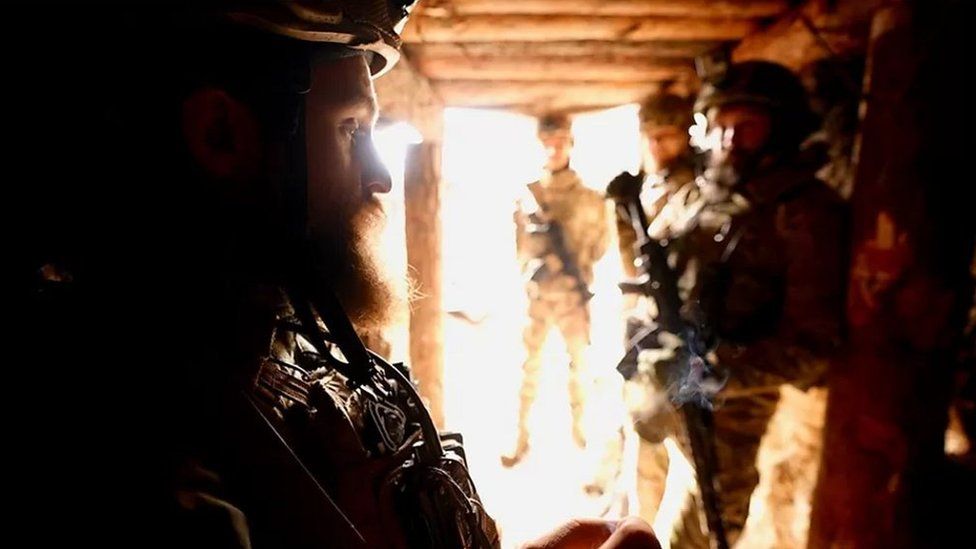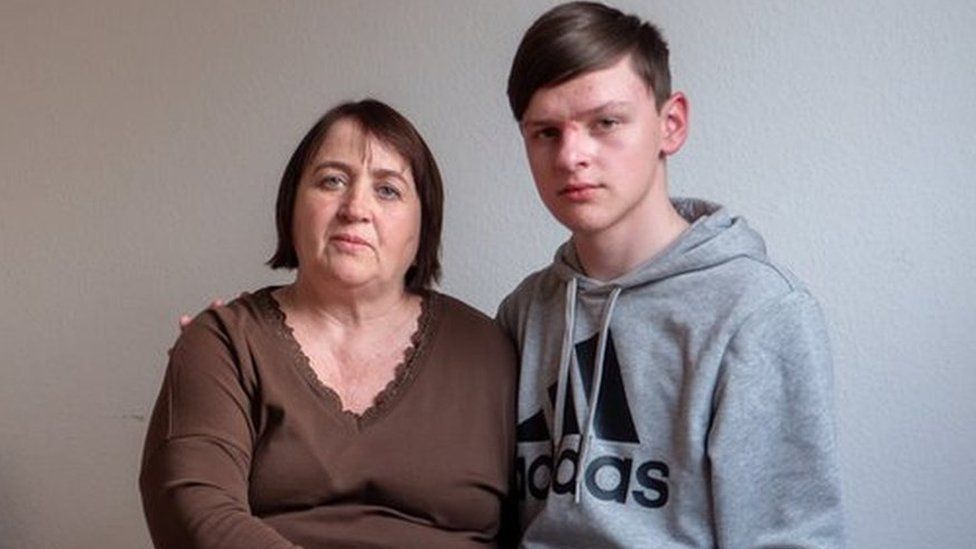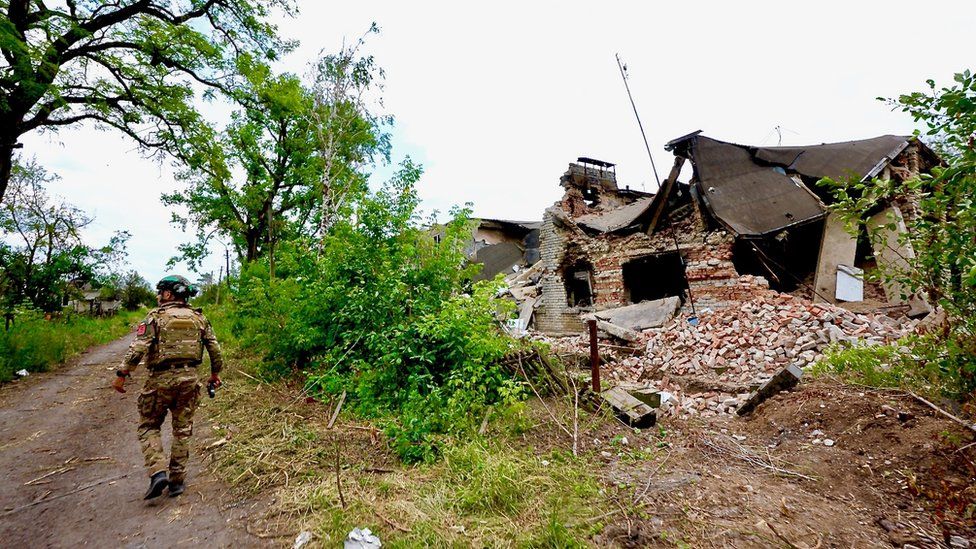
Two weeks since the counter-offensive began, Ukraine is making modest but steady progress in three areas of attack across the 1,000km (620 mile) front line.
Troops are launching probing attacks, while most of Ukraine’s forces are being held in reserve, waiting for a big enough opening in Russian defences to launch a main attack and try to recapture land in the south of the country.
The fighting has been hard, with heavy casualties on both sides, and opposing armies claiming the upper hand. Ukraine’s advance in southern Donetsk has stuttered, but continues.
The BBC joined the 68th Jaeger Brigade as its combat forces sought to expand their control eastward of the recently regained village of Blahodatne.
In their sights were a series of trenches protecting Russian forces on nearby hilltops.

The men of a specialised drone unit grab cameras, roll cables and load a pickup truck with tins of ammunition, crates of smoke grenades and armour-piercing rounds.
Aside from them, there’s little sign of life in Blahodatne. Down a lane, the wreckage of two heavily armoured American-made MRAP vehicles lie stranded, one a burnt-out shell. There are more of these mine-resistant vehicles disabled in the fields beyond.
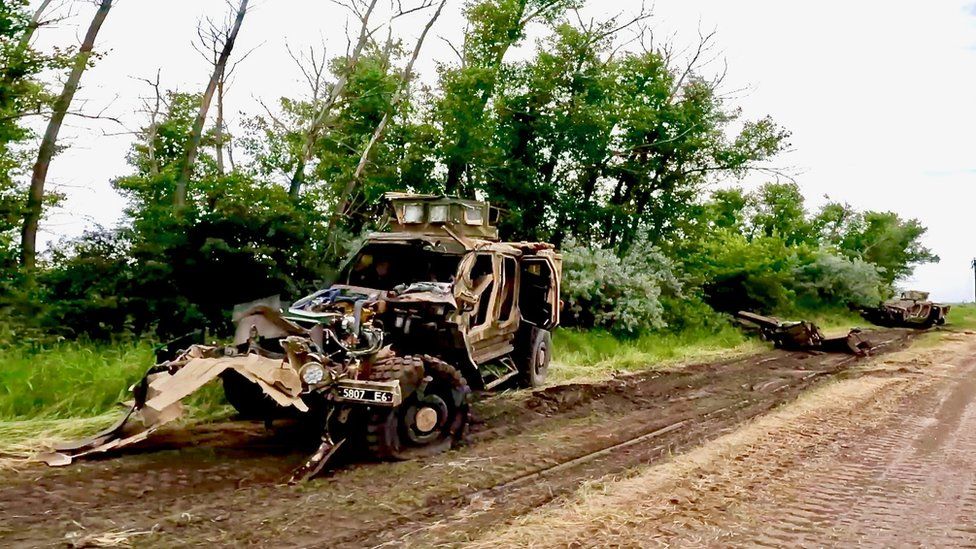
“Steer clear of those, the Russians keep hitting them,” we are warned. Russia has made much of the losses of Western-donated tanks and vehicles, even as Vladimir Putin admitted it has lost dozens of tanks since the counter-offensive began on 5 June.
Troops are attacking at three points: Bakhmut, where they are advancing north and south of the city, which remains firmly under Russian control; south of Zaporizhzhia; and in southern Donetsk, where a number of villages have been taken back.
Blahodatne is one of those. Another salvo comes in and the soldiers take cover in the cellar of a ruined house.
A dirt floor passageway is lit with oil lamps, casting soft yellow light down its length to a stone and iron stove with three sturdy pots atop. Towels hang from a washing line. A rough wooden door opens and, in a headscarf, Nina Fedorivna emerges.
She has been living down here for the past year. Russian soldiers came by only once, she says.
She never, for a second, considered leaving the village.
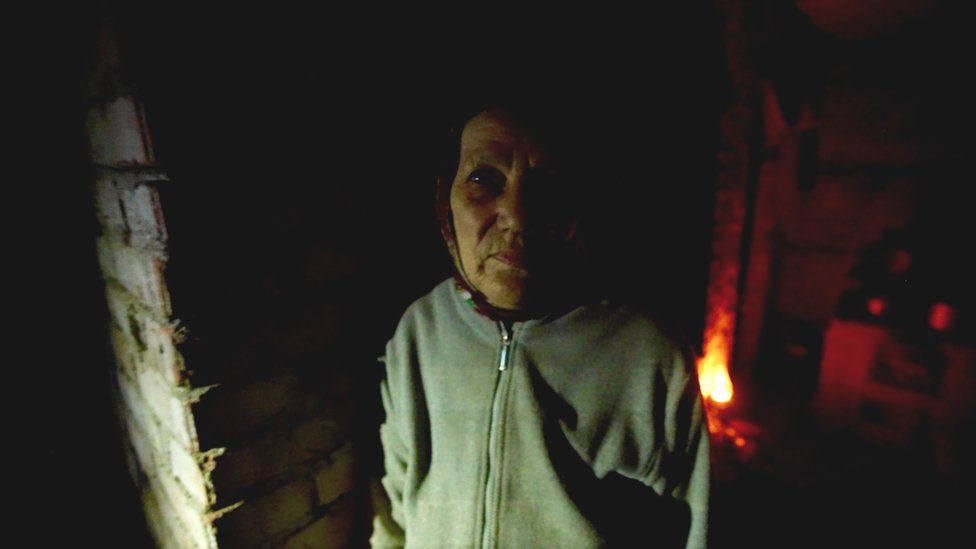
The artillery barrage over, we leave through a lane at the end of her house. Three Russian corpses lie in a ditch, just beyond Nina Fedorivna’s vegetable patch. A truck with the Z symbol, which was used by Russian forces, sits nearby riddled with bullet and shrapnel holes. The fighting here was at close quarters.
Throughout the village roses are in bloom – but the smell of corpses catches the back of your throat.
There’s no time to delay – the soldiers have an air of concentration and purpose. They are clearly preparing for something.
They head east, leaving Blahodatne behind. The two-car convoy is well spaced in case of Russian attack. The fields around are heavily mined, poles with red-and-white ribbon mark cleared ground.
As we get close to another abandoned American armoured vehicle, there’s an explosion, just missing the wreckage. It is likely from a Russian drone.
I was in this area back in March. Then, the front lines had barely moved a few metres in months. Russia was using far more artillery than Ukrainian forces, who mainly hunkered down in trenches waiting for the barrages to end. At the time, a commander told me they were conserving their shells for the counter-offensive. On this visit, Ukrainian guns didn’t stop for the two days I was with the brigade.
The cars speed on to a network of trenches hidden in a line of trees. There, company commander, Senior Sergeant Andrii Onistrat, 49, runs his men through their next mission – a Ukrainian assault is planned for the next day on the Russian trenches, 3km (1.8 miles) away at the foot of the low hills to the south.
In their attempt to widen the front, sections of the 68th Brigade will attack from the countryside east of Blahodatne and Makarivka, across minefields and directly in the line of Russian fire.
Sgt Onistrat runs through the drone team’s communication protocols and targets. The section loses as many as five drones a day. Tanned and with a brilliant white grin, he looks at his grim-faced men and gives one final order: “Smile – why are you so serious? We are winning the war.”
Smile, why are you so serious? We are winning the war
Twenty-four hours later, most of the same men are in a sweltering dugout. The attack is under way.
From their surveillance cameras I can see two armoured vehicles slowly making their way through the minefield. Drone after drone is sent above the Russian positions dropping smoke grenades, creating a smoke screen along the Russian-occupied trenches to allow vehicles to advance and confuse enemy anti-tank weapons. As I watch, Ukrainian shells repeatedly strike the treeline.
Yuri, a young soldier, runs in and out of the dugout, changing drone batteries and sending them into flight, while voices bark orders and target positions across the radios. Mosquitoes and horseflies are feasting on the men, but still “Frisbee”, from western Ukraine, has taken his shirt off because of the heat.
Their enemy isn’t holding back. As I stand outside, a Russian strike lands close enough to throw dirt into the trench. Standing lookout in wrap-around shades and without body armour is Zheka.
Another Russian shell lands close and I hit the ground. I look up and Zheka hasn’t flinched. He shouts in English – expletives directed at the Russians – and gives two middle fingers to the air. Salvoes of Grad rockets rain down on Ukrainian positions.

More broadly, the counter-offensive is made more difficult because of the lack of Ukrainian air power. The West has promised F-16 fighter planes, but they will not arrive until later this year.
Back outside in the trenches, another soldier, Yaroslav, explains: “Russian helicopters, Russians jets fire at every area, every day”. He’s interrupted as another strike lands nearby. “Go to the shelter, good luck,” he says.
When, on 3 June, President Volodymyr Zelensky announced that Ukraine was ready for the counter-offensive, he mentioned Russian air superiority and warned many Ukrainian lives would be lost. And so it has been for the 68th Brigade.
Sgt Onistrat says this weighs heavily on him. “The severity of the day depends solely on one thing – the number of people we lose. The last week has been extremely difficult. We have lost a large number of people.”
On his head he wears a ballistic helmet, a size too small. I mention it and he starts to weep. “It was my son’s,” he says.
Ostap Onistrat, 21, was killed in a drone strike not far from where we speak, a couple of days before the counter-offensive began. He’d been in the army a year.
His father is still in the throes of grief. “A kamikaze drone flew to them and in fact hit him directly. It was impossible to recognise him. He was buried in a closed coffin,” Sgt Onistrat says.
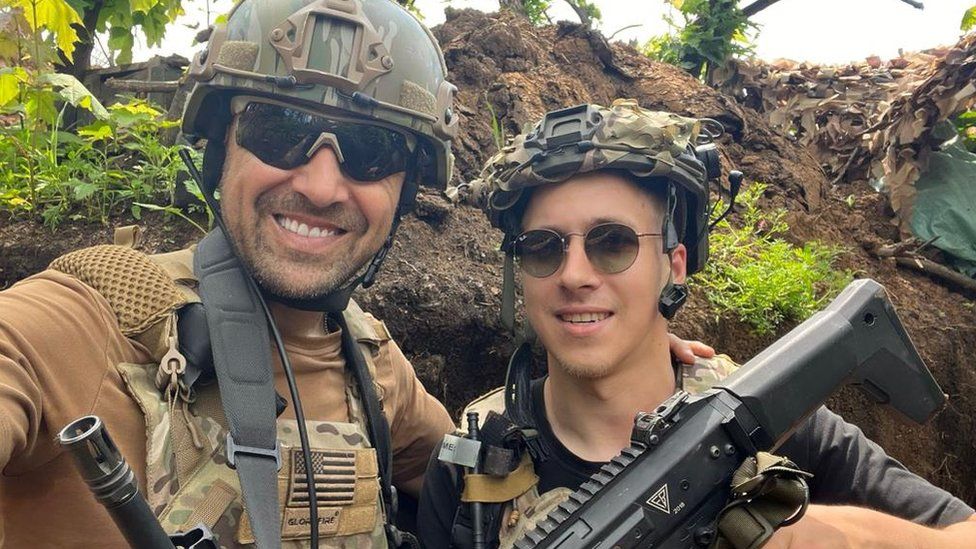
How does he go on, I ask. “I made a commitment. You know, we’re here to win. Not to sit back, not to escape. I just think that every person here must do their job professionally. There is nothing heroic in it. I just have to finish this job.”
When I ask if he’s looking for revenge, he replies firmly: “Revenge is a sin.
“My task is to bring this story to an end. I want to take part in the victory parade. I want us to win, and I want to lose fewer people.”
We leave the front, the offensive still under way. Later, I received a message telling me they’d taken the Russian positions.
Returning to the command post, Sgt Onistrat’s car escorting us swerves and comes to a sudden stop. He, along others, quickly exit the vehicle. I wonder if we too need to take cover.
Then I see what’s caught their attention – cherry trees.
Like kids, they laugh carefree for a moment as they grab handfuls of the dark red fruit from the shady branches, as artillery and mortar fire continues to hammer Russian positions on the hillside.
Follow Quentin Sommerville on Twitter.
Related Topics
-
-
22 December 2022
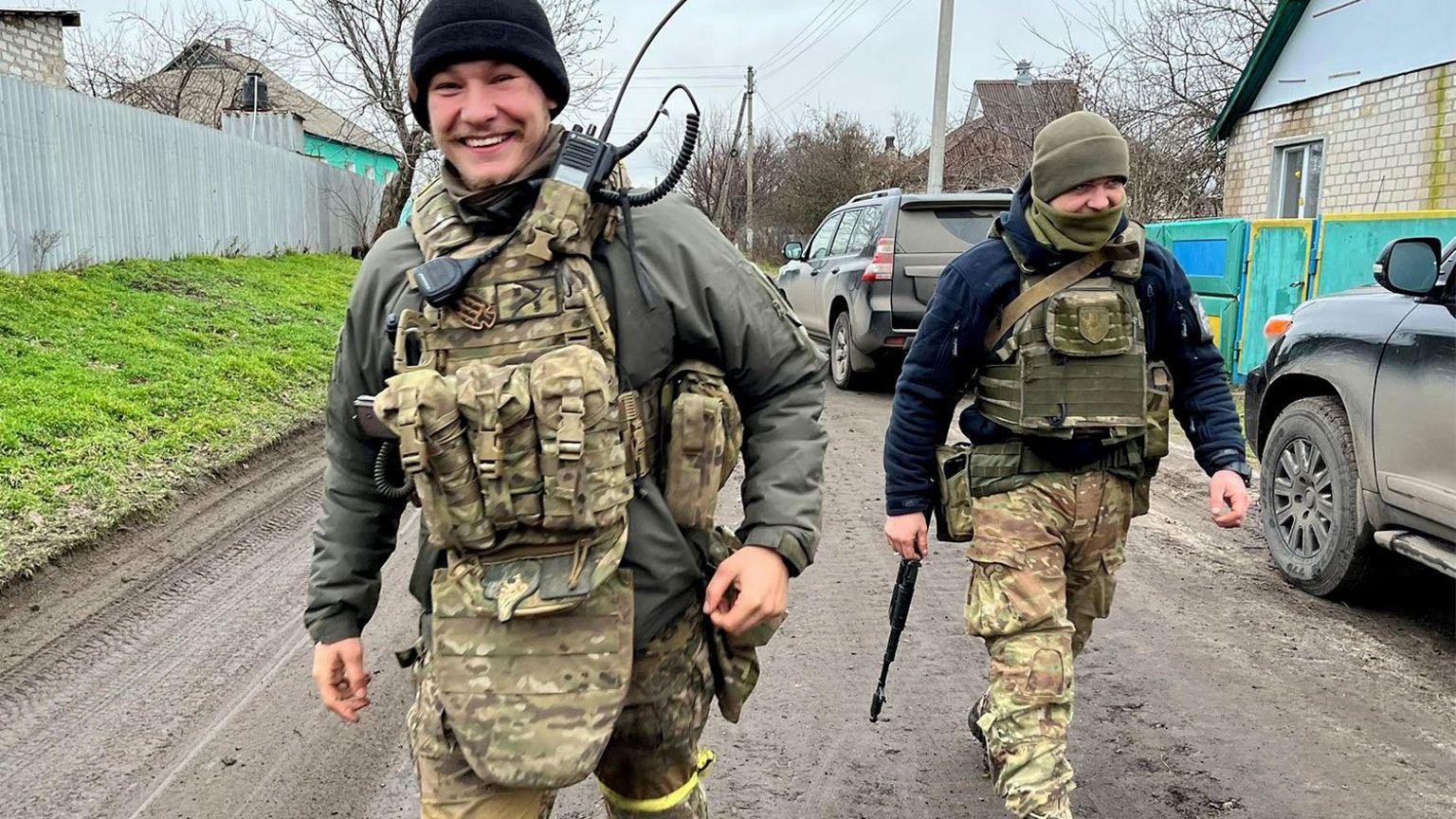
-

